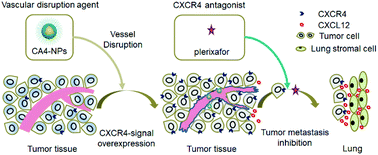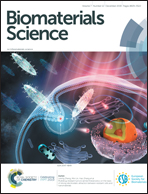Combretastatin A4 nanodrug combined plerixafor for inhibiting tumor growth and metastasis simultaneously
Abstract
Inhibition of tumor growth and metastasis simultaneously is an important issue for tumor therapy. The CXCR4/CXCL12 axis plays a crucial role in cancer metastasis, and the blocking of the CXCR4/CXCL12 axis is an effective way of inhibiting cancer metastasis. Combretastatin A4 nanodrug (CA4-NPs), a neogenesis blood vascular disrupting agent, can accumulate around blood vessels and disrupt tumor neogenesis of blood vessels more efficaciously than typical small molecular drug combretastatin A4 phosphate (CA4P). However, in this work, we find that the CXCR4 expression is significantly enhanced in CA4-NPs-treated tumor tissues in a metastatic orthotopic 4T1 mammary adenocarcinoma mouse model. Considering that the overexpression of CXCR4 can promote tumor cell metastasis, a novel cooperative strategy that utilizes plerixafor (PLF, CXCR4 antagonist) with CA4-NPs for inhibiting tumor growth and metastasis simultaneously is developed. The combination of CA4-NPs (60 mg kg−1 on CA4 basis) + PLF shows remarkably enhanced antitumor efficacy. The tumor growth inhibition rate of the combination group reaches 91.3%, significantly higher than those of non-cooperative groups. In addition, the number of lung metastasis foci of the combination group is least among all groups. This cooperative strategy provides a useful method for inhibiting tumor growth and metastasis simultaneously, and gives the evidence to support the clinical use of the combination of vascular disruption agents and CXCR4 antagonists.



 Please wait while we load your content...
Please wait while we load your content...